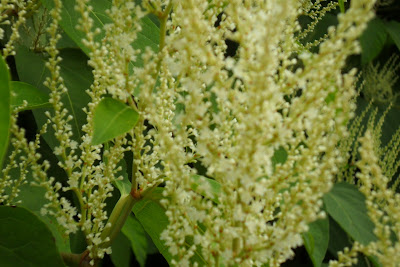The last serious nectar flow we have in western Washington is Japanese Knotweed. I will start out by catagorically stating that this is a non-native invasive species and nothing in this blog should be construed to encourage anybody to plant or cultivate Japanese Knotweed. That having been said, it is a dynamite honey plant and produces the best dark honey I have ever tasted. As a general rule dark honeys are more strongly flavored than light honeys. They are also reputed to be more healthy as they have more anti-oxidants than light honeys. However, many dark honeys have strong unpleasant aftertastes. Buckwheat and Western Sumac are both good examples of this general trait of dark honeys. Some people have grown up with honeys such as this and describe the light honeys as lacking in flavor. I, on the other hand, do not care for the "funky' flavors of many of the dark honeys. If the only honey I have on hand is buckwheat honey, as far as I'm concerned I am out of honey. Japanese Knotweed honey is a notable exception among the dark honeys. While it is strongly flavored, no aspect of the flavor can be described as unpleasant or odd. Knotweed honey has a strong and loyal following among the Beez Neez customers.
Japanese Knotweed is a tall plant, growing to about six or seven feet tall, with large heartshaped leaves. It has a jointed stalk which has led it to be called beautiful bamboo. It is not a bamboo but is actually a member of the buckwheat family. It produces a massive amount of roots which make it very difficult to eradicate. It is like the mythical hydra when you try to pull out the roots. Every little broken piece of rizome can start a new plant. It readily colonizes along streams and rivers can can be found in many other places in our damp climate. When it blooms it produces a mass of wispy upright white flower clusters It was originally introduced into the United States as an ornamental, but it quickly escaped to the wild and has become a significant problem plant in many parts of the country.
The nectar flow from Japanese Knotweed starts in mid August and lasts through mid or late September. This makes it somewhat of a challenge to harvest knotweed honey as this is the exact time that many beekepers are doing fall medications. I know of one sideline beekeeper who charges a premium for his knotweed honey due to the disruption it causes to his normal management scheme to harvest it. While the plant is fairly widespread along the river systems and not uncommon in other places, not every beehive will produce knotweed honey. My beehives are only a mile away from the Pilchuck River which has lots of knotweed growing along its banks. That seems to be far enough away such that most of my beehives don't produce a significant amount of knotweed honey. Mainly the bees use it to backfill areas of the broodnest as the broodnest shrinks in the late summer and early fall. I'm assuming my bees might produce more knotweed honey if I lived a little closer to the river.
The above photos of Japanese Knotweed were taken today (August 14) along the bank of the Pilchuck River, just north of Snohomish. The flower clusters are just starting to open and the bees have just begun to show an interest in the blooms. If anyone has an interest in learning more about Japanese Knotweed the local county weed control board is usually a good source of information.



No comments:
Post a Comment